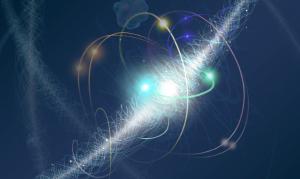Blog
Round and Round
12 November 2018
 Nicolle R. Fuller, NSF
Nicolle R. Fuller, NSFElectrons are interesting things. They help form the structure of atoms and molecules, they can flow through conductive materials to create electric currents, and they have a strange quantum behavior that is sometimes particle-like and sometimes wave-like. And as far as we can tell, they are perfectly spherical. This has some interesting implications for cutting-edge physics.
When we imagine what electrons look like, we typically have the wrong idea. Often electrons are portrayed as little particles orbiting a nucleus, like planets orbiting a star. But as quantum objects, electrons aren’t particles. They don’t orbit the nucleus of an atom, but rather surround it in a fuzzy quantum cloud. Electrons can exhibit particle-like behavior in certain experiments, but they are not hard, solid objects in the way we think of particles. What’s more, electrons are elementary particles. While the nucleus of an atom is made of neutrons and protons, which are in turn made up of quarks, electrons are just electrons. They aren’t made of even smaller particles.
So what does it mean to say that these fuzzy quantum objects are spherical? It all comes down to something known as an electric dipole moment. A dipole moment occurs when the charge of some object isn’t evenly distributed. For example, water molecules have a dipole moment because the molecular bonds between the oxygen atom and the hydrogen atoms means the negatively charged electrons are a bit offset from the positively charged nuclei. Lots of molecules have electric dipole moments, because molecules aren’t elementary particles. Since electrons aren’t made of smaller particles, it would seem obvious that electrons can’t have a dipole moment.
But there’s a catch. While they electrons are elementary particles, they also have a property known as spin. This is similar to the angular momentum of a rotating object, except that it’s just an inherent property of electrons. In the standard model of quantum physics, electron spin doesn’t distort the distribution of charge in an electron, so electrons shouldn’t have a dipole moment. In other words, they should be spherical. But there are hints that the standard model might be wrong, and some alternative models predict that (yet undiscovered) super-massive particles could interact with electron spin to give electrons a tiny dipole moment. If an experiment showed that electrons aren’t perfectly spherical, it would show the standard model is wrong.
So the ACME collaboration set out to measure the dipole moment of electrons.1 ACME stands for Advanced Cold Molecule Electron EDM. In their experiment they shined lasers on thorium monoxide (ThO) molecules. This caused electrons in the molecules to emit light. By measuring the light emitted by the electrons, they could determine just how spherical electrons are. Their experiment was so precise that if an electron were the size of Earth, they could tell if it was non-spherical by a tiny fraction of a human hair. But to the limits of their experiment, electrons seem to be perfectly spherical.
As far as we can tell, the standard model for electrons is right. That means some of the alternatives to the standard model have to be wrong.
ACME Collaboration. Improved limit on the electric dipole moment of the electron. Nature, volume 562, pages 355–360 (2018). ↩︎